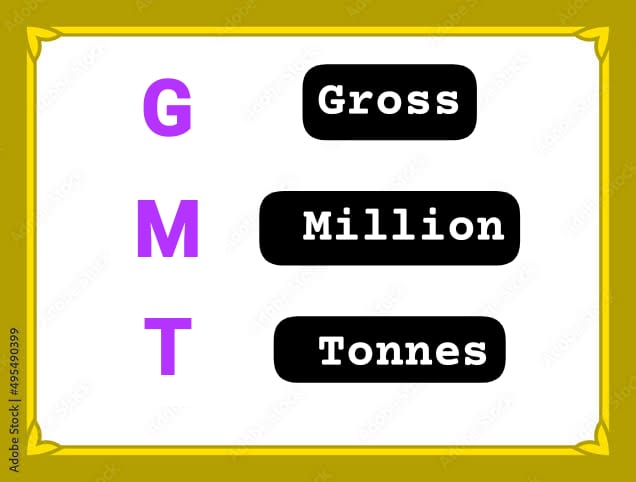
GMT - Gross Million Tonne (Statistics in IR)
What is GMT ?
Gross = Total Load i.e., Carrying Capacity (Tare Load + Payload)
Million = 10 Lakhs
Tonne = 1000 Kgs
I.e., 100 Crores Kgs or 1 Million Tonne
GMT is a primary performance metric - serves 3 groups of Railway Statistics in IR Statistics Manual i.e., 1. Economic Statistics 2. Transportation Statistics & 3. Administrative Statistics.
GMT data of every train on every line - captured on FOIS / ICMS / CoA
FOIS stands for Freight Operations Information System
ICMS stands for Integrated Coaching Management System
CoA stands for Control Office Application
Traffic Density Data (GMT) - an integral part of Indian Railways IT Systems architecture.
Why GMT is important: GMT data is a crucial decision criterion for
Planned Track Renewals
Preventive maintenance (like periodicity of USFD - Ultrasonic Flaw Detection)
Riding quality (Track degradation model)
Effective allocation of rails, track materials & resources, among works/projects under Plan Heads 11 - New Lines, 15 - Doubling & 31 - Track Renewals.
Existing mechanism (up to 2022-23) - calculation of GMT
Computed by Zonal Railways
Basis is GTKM & Lead (Kms)
Manually input in TMS - Track Management System
Limitation is for sections with more than 2 lines (i.e., 3rd/4th line), the line wise GMT data is not available.
New mechanism - from 2023-24 onwards - calculation of GMT
Zonal Railways would provide GMT data by May of the following year. Example: For 2023-24 the data should be available by May 2024 and so on.
All GMT data in TMS - sync (API based) with the systems architecture
API stands for Architecture Programming Interface
No physical copies. No manual input in TMS - Track Management System
No signed copies in parallel
GMT data from FOIS/ICMS/CoA would flow daily into TAMS - Traffic Accounts Management System ( SMRTI - Statistical Module on Rail Transport Information)
From TAMS to TMS
From 2024-25 onwards - GMT data - refined format i..e, Block section wise Line wise (earlier line was not available)
Zonal Railways Statistical Units (under PFA) - issue Monthly & Annual GMT Data
SPOC for Statistical Information Module - GM/TAMS @ CRIS
SPOC for input data of FOIS/ICMS/CoA - GM/OR @ CRIS
SPOC stands for Single Point of Contact
It is calculated for Railway Tracks involving multiple factors and is a complex process.
It is determined through detailed engineering analysis and simulation.
GMT Calculated for Railway Tracks involving multiple factors. These are:
Axle Load: Higher axle loads leads to greater wear and tear.
Train Speed: Higher speeds can cause track degradation.
Train Frequency: The number of trains passing over a track within specified time (Line Capacity) can affect stress & wear on the track.
Track structure & Material: Ballasted or non-ballasted track and the material used play a significant role in determining load capacity & maintenance requirements.
Climate & weather: Extreme temperature or heavy rainfall conditions impact the Track’s durability.
Track maintenance practices: Frequency of track maintenance influences the overall track performance.
Note: The above instructions are in supersession of any previous instructions on the subject (GMT) and in the event of conflict with any other instructions / part of any other instructions, the above instructions would prevail.
Key points - GMT
GMT is a primary performance metric - serves 3 groups of Railway Statistics in IR Statistics Manual i.e., 1. Economic Statistics 2. Transportation Statistics & 3. Administrative Statistics.
Statistical units in Zonal Railways - under control of PFA
GMT - Revised policy w.e.f 01.4.2024 onwards (or FY 2023-24 onwards)
GMT means Traffic Density Data
GMT data from FOIS/ICMS/CoA would flow daily into TAMS - Traffic Accounts Management System ( SMRTI - Statistical Module on Rail Transport Information)
From TAMS to TMS
No physical copies. No signed copies. No manual input in TMS
From 2024-25 onwards - GMT data - refined format i..e, Block section wise Line wise (earlier line was not available)
Zonal Railways Statistical Units (under PFA) - issue Monthly & Annual GMT Data
SPOC for Statistical Information Module - GM/TAMS @ CRIS
SPOC for input data of FOIS/ICMS/CoA - GM/OR @ CRIS
Abbreviations
GMT - Gross Million Tonne
FOIS - Freight Operations Information System
ICMS - Integrated Coaching Management System
CoA - Control Office Application
USFD - Ultrasonic Flaw Detection
TMS - Track Management System
GTKM - Gross Tonne Kilometer
API - Architecture Programming Interface
SMRTI - Statistical Module on Rail Transport Information
SPOC - Single Point of Contact
CRIS - Centre for Railway Information Systems
—-end—-